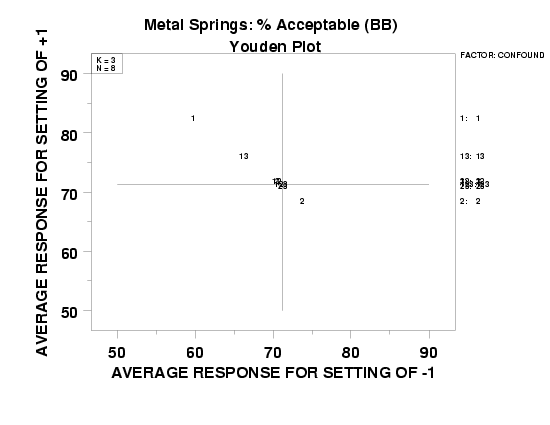5.5. Advanced topics
5.5.9. An EDA approach to experimental design
5.5.9.6. |
DOE Youden plot |
-
What are the important factors (including interactions)?
In a design of experiments context, we borrow this duality emphasis and apply it to 2-level designs. The 2-component emphasis of the Youden plot makes it a natural to be applied to such designs.
- Ranked list of factors (including interactions); and
- Separation of factors into two categories: important and unimportant.
- Vertical Axis: Mean response at the "+" setting for each
factor and each interaction. For a given factor or interaction,
n/2 response values will go into computing the "+" mean.
- Horizontal Axis: Mean response at the "-" setting for each factor
and each interaction. For a given factor or interaction,
n/2 response values will go into computing the "-" mean.
- Plot Character: Factor/interaction identification for which
-
1 indicates factor X1;
2 indicates factor X2;
...
12 indicates the 2-factor X1*X2 interaction
123 indicates the 3-factor X1*X2*X3 interaction
etc.
From the definition above, the DOE Youden plot is a scatter plot with the "+" averages on the vertical axis and the "-" averages on the horizontal axis. Thus, unimportant factors will tend to cluster in the middle of the plot and important factors will tend to be far removed from the middle.
Because of an arithmetic identity which requires that the average of any corresponding "+" and "-" means must equal the grand mean, all points on a DOE Youden plot will lie on a -45 degree diagonal line. Or to put it another way, for each factor
-
average (+) + average (-) = constant (with constant = grand mean)
-
average (+) = constant - average (-)
- A ranked list of factors (including interactions).
The intersecting dotted lines at the center of the
plot are the value of the grand mean on both the vertical
and horizontal axes. Scan the points along the negative-slope
diagonal line and note as to whether such points are clustered
around the grand mean or are displaced up or down the
diagonal line.
- Which point is farthest away from the center? This defines the "most important" factor.
- Which point is next farthest away from the center? This defines the "second most important" factor.
- Continue in a similar manner for the remaining points. The points closest to the center define the "least important" factors.
- Separation of factors into important/unimportant categories.
Interpretationally, if a factor is unimportant,
the "+" average will be about the same as the "-" average,
so the plot of "+" vertically and "-" horizontally will be near
the grand mean of all n - 1 data points.
Conversely, if a factor is important, the "+" average will differ greatly from the "-" average, and so the plot of "+" vertically and "-" horizontally will be considerably displaced up into the top left quadrant or down into the bottom right quadrant.
The separation of factors into important/unimportant categories is thus done by answering the question:
-
Which points visually form a cluster around the center?
(these define the "unimportant factors"--all remaining
factors are "important").
- Ranked list of factors (including interactions):
- X1 (most important)
- X1*X3 (next most important)
- X2
- other factors are of lesser importance
- Separation of factors into important/unimportant categories:
- "Important": X1, X1*X3, and X2
- "Unimportant": the remainder


